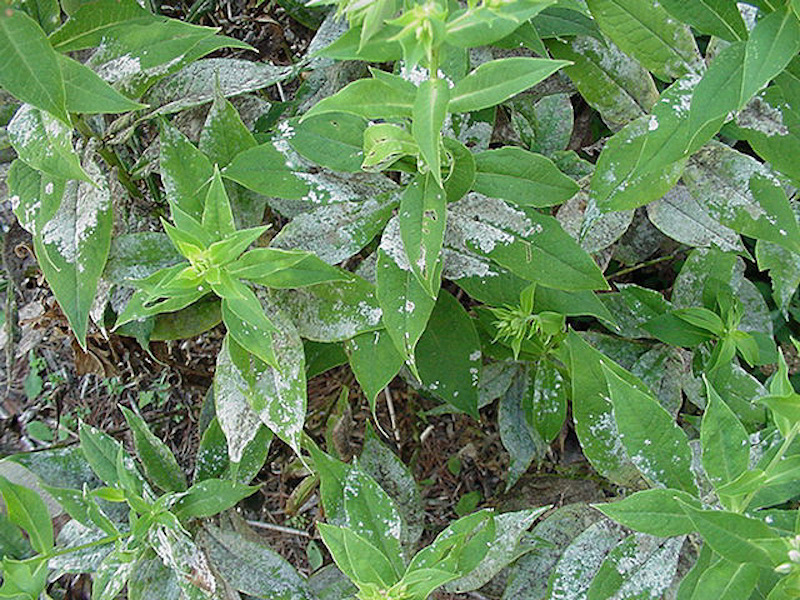Depending on the variety, phlox produces abundant, brilliant blooms in shades of pink, purple, and blue. Maintaining this easy-to-grow perennial means keeping common diseases at bay or treating them upon first sight. Three common diseases to be concerned about are powdery mildew, leaf spot, and root rot.
If you reside in a hot, humid climate, fungal diseases are likely to be more of an issue. Water the base of the plant, and not the foliage, when the top layer of soil is dry to the touch.
Phlox Powdery Mildew
If you walk outside one early summer morning and notice a powdery covering, like flour, on the foliage of your phlox, the plant likely is suffering from powdery mildew. If left untreated, phlox’s leaves will eventually turn yellow, die, and fall.
Prevent powdery mildew using a homemade spray consisting of 1 tablespoon of baking soda, 1 gallon of water, and a few drops of organic liquid soap, paying extra attention to spraying the undersides of the leaves. Try to select phlox varieties with resistance to powdery mildew. Also, provide adequate space between your plants, as good air circulation can discourage the development of fungal disease.
Identifying Powdery Mildew
Powdery mildew is characterized by blotches of a white, powdery substance on phlox’s foliage and stems. The leaves may eventually turn yellow and fall from the stems.

Photo courtesy of Tom Crewell
Treating Powdery Mildew
Prevent powdery mildew by spraying phlox with an antifungal mixture of about 1 tablespoon of baking soda, 1 gallon of water, and a few drops of organic liquid soap. To treat an active outbreak, spray the plant with copper-containing fungicide or horticultural oil.
Phlox Leaf Spot
Leaf spot is a fungal disease that often appears on phlox’s lower foliage after a long period of rain. The spots are small and pale gray, surrounded by darker borders. If left untreated, the leaves will begin to dry up, die, and fall from the plant.
If leaf spot is detected, prune and discard the infected foliage and stems. Then, treat with a horticultural oil such as neem oil, or a copper-containing fungicide.
Identifying Leaf Spot
Leaf spot appears as small pale-colored spots encircled by darkish-brown rings. They typically form on phlox’s lower leaves before spreading upwardly.
Treating Leaf Spot
To prevent leaf spot, spray phlox with a homemade mixture of 1 gallon of water, a few drops to a half teaspoon of organic soap, and 1 tablespoon of baking soda. To treat an infection, spray neem oil or a copper-containing fungicide on the affected foliage and stems.
Phlox Root Rot
Garden phlox is susceptible to black root rot caused by Thielaviopsis basicola. Conditions that favor this pathogen include cool temperatures, alkaline soil, high humidity, and poor air flow. The plant may look malnourished or underwatered due to yellowing of the leaves. In advanced cases, you may see black areas forming on the stem.
Prevention is the best way to deal with root rot. Provide adequate spacing when planting phlox; refrain from overhead watering; clean pruning shears after working on a plant; and spray foliage with an antifungal spray containing baking soda. Once infected, however, phlox will often languish and should be removed.
Identifying Root Rot
Root rot can cause yellowing, wilting, and dropping of leaves, stunted growth, and the formation of black areas along the stems, leaves, and roots. Darkened areas may become soft and mushy to the touch.
Treating Root Rot
Fungicides may be beneficial if the disease is identified early on; otherwise, affected plants should be removed and discarded. Avoid planting any susceptible species in the same area, as the spores can live in the soil for a long time. To prevent root rot, select a planting site with good drainage, water early in the morning, and clean garden tools after each use. Also, avoid over-watering and over-fertilizing, which make plants more susceptible to fungal diseases.
Phlox Disease Chart
|
Disease |
Identifying |
Treating |
|
Powdery Mildew |
Yellow or white spots on leaves |
Fungicides & air circulation |
|
Leaf Spots |
Dark spots on leaves |
Fungicides & air circulation |
|
Phlox Root Rot |
Black areas on stems and roots |
Fungicides, improve drainage and air circulation |
Sources:
"Phlox." Texas A&M AgriLife Extension Service. plantdiseasehandbook.tamu.edu
"Phlox (Phlox)." Connecticut State - The Connecticut Agricultural Experiment Station. portal.ct.gov
 |
Author Suellen Barnes - Published 6-07-2023 |
